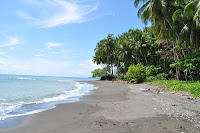

Left image: Housing straight out of old geography textbooks
Right image: Jungle vista, Madang Province.
Related sites to the Spatialworlds projectSpatialworlds website21st Century Geography Google GroupAustralian Geography Teachers' Association website'Towards a National Geography Curriculum' project websiteGeography Teachers' Association of South Australia website Email contactmanning@chariot.net.auWhere am I??Sydney: S: 34º 0' E: 151º 0'
Using the ESRI AEJEE as a stepping stone to using GIS in the classroomFor those trained and competent with GIS it has always been a temptation to “go for the jugular” with GIS when working with teachers. Yes, being able to use GPS, geocode, register images and create your own databases are indeed what the use of GIS is all about for the user of experience but for time poor teachers with limited ICT knowledge or application and possibly only teaching geography as one of their assignments in a school, learning GIS is indeed problematic. It is the daunting steepness of the GIS learning curve is what puts teachers off even starting to learn. It is simply too much to take on in one jump and because of the demands of daily classroom life, one jump is often all that can be spared. Since 1997 I have been working at developing resources and professional learning for teachers which reduces the hurdles and reduces the gradient of the learning curve. Between 2002-2006 the uptake in schools using ESRI ArcView GIS was steadily growing through initiatives such as the “Making GIS achievable” professional learning program in South Australia, the Innovative Technology centre in Queensland and the
“Making GIS happen” resources available from TECHGEOG. These initiatives were based on the KISS (Keep It Simple S...) principle and those involved considered that slowly but surely teachers were taking up the use of GIS. However with the advent of
ArcGIS as the designated ESRI software for schools in 2006 (The simpler
ESRI ArcView software was no longer available to schools because of its incompatibility with the new server software and Microsoft Vista) the learning curve just became too steep for most teachers.
Anecdotally, schools, whilst using spatial technologies such as Google Earth and others, are less involved in the intricacies of using
GIS platforms than they were only a few years ago.
There are a range of reasons for this but I suggest the major one is the lack of comfort of teachers with the complex GIS software as a starting point. In response to this I have been experimenting in several South Australian schools with using the simple and user friendly free ESRI GIS product called
AEJEE.
Although the product has been free to download for some time it has not been actively promoted as a way to start in the secondary setting and as an adequate product for the needs of most primary school classes. In these trial schools for the Australian Curriculum: Geography I am working with primary and secondary school staff to learn the software in as much detail as possible and then to develop programs using the functionality of AEJEE. AEJEE can do almost everything required for initial use of GIS in the classroom (thematic maps, layer applications, layer customization, attribute table viewing etc). My premise in this work is that once teachers get confident with software which has a much more gradual leaning curve they will then gain the confidence to learn the more complex GIS platforms such as ArcGIS,
MapInfo etc.
Most importantly they have become conversant with GIS language, software applications, GIS commands and most importantly the possibilities of GIS in the classroom. Such awareness prepares and provides teachers with confidence to negotiate the next step having had a good experience with the AEJEE program. The experience also, hopefully, will convince them that the time spent in learning GIS to the next level will be time well spent for their teaching and their students learning. Although I have focused on AEJEE in this posting and the trial schools I am working in, maybe Spatial Genie and other webserver GIS application such as
ArcGIS Explorercould be the base starting point for such an approach in the future. As the posting states, out of small thing, big things grow – when applied to the use of GIS in the classroom, from a simple achievable start using a product such as AEJEE, teachers can grow into using more complex GIS platforms in the future. They will not fall at the first hurdle as I feel is happening across Australia with teachers being overwhelmed with fully professional products such as ArcGIS. More on how the trial has gone in a future posting. I may be wrong but …









